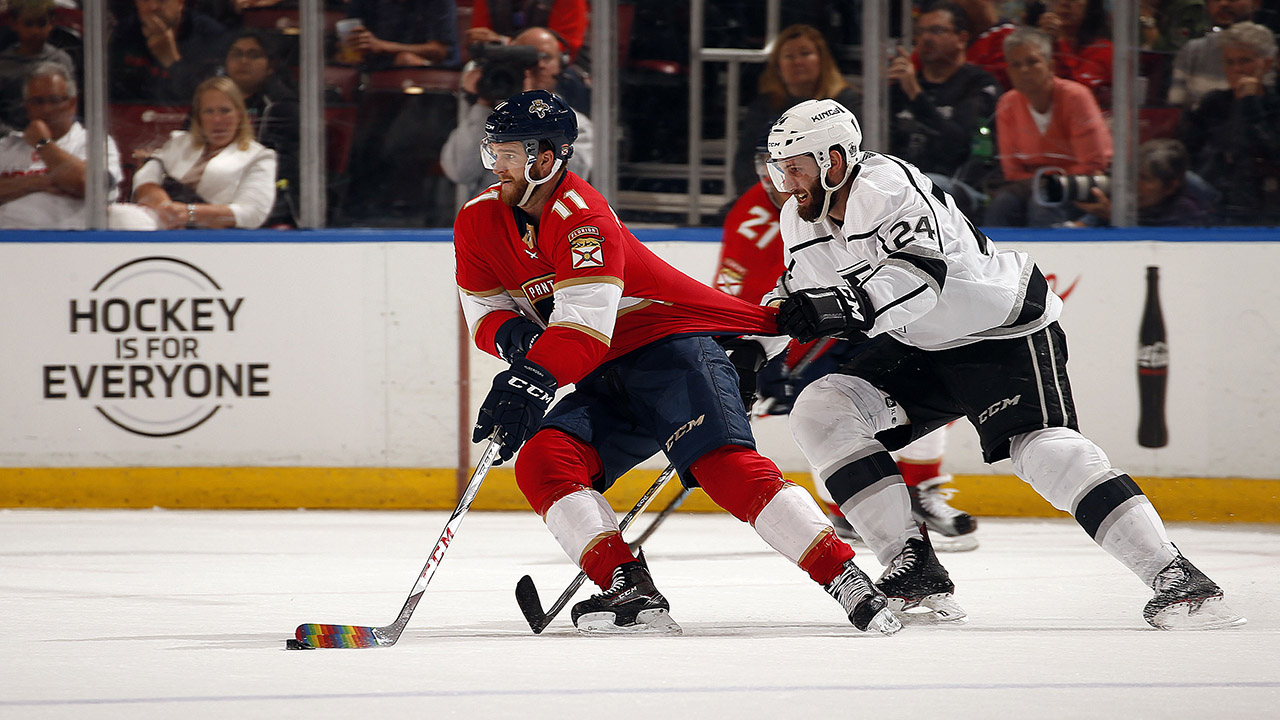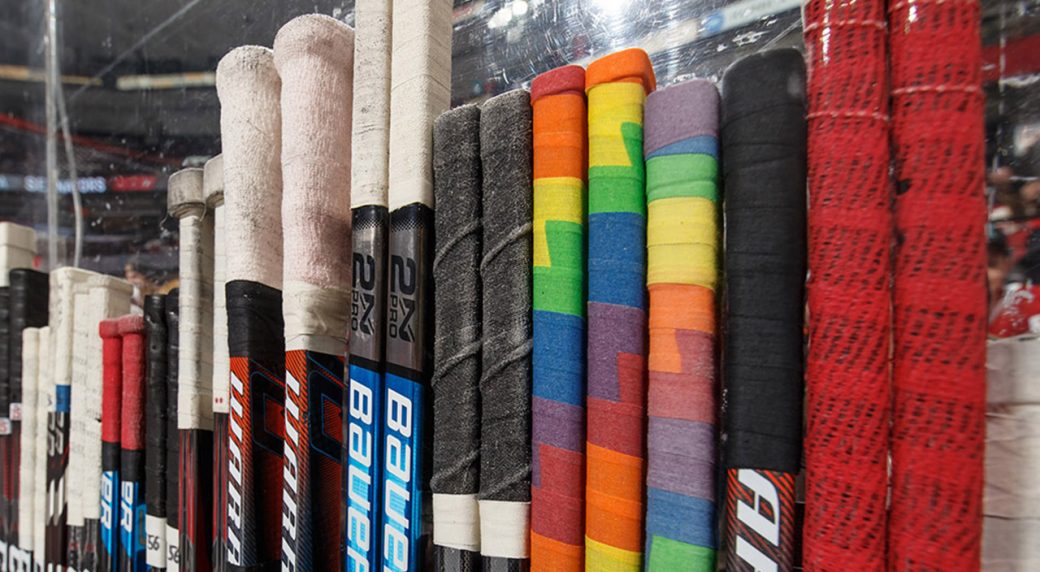It is indicative of both a meaningful step forward and the long, untested path still waiting ahead that thoughts of hockey’s engagement with the LGBTQ community drift so quickly to one image — vibrant, rainbow-coloured tape wrapped around sticks, replacing the customary black or white.
Now a familiar feature of the hockey world and its slow bend towards progress, Pride Tape has come a long way since it was first dreamed up a half-decade ago. It started with a simple question, says co-founder Dr. Kristopher Wells, the Canada research chair for the Public Understanding of Sexual and Gender Minority Youth at MacEwan University: “How do we help young people, particularly LGBTQ youth, stay in sport? And stay in the game of hockey?”
Back in 2015, Wells was discussing that question with Jeff McLean, then-creative director of Calder Bateman Communications. The conversation came as part of an annual reconvening of the duo after they’d previously launched an impactful project called NoHomophobes.com — an online tool that tracks homophobic language on Twitter.
The need to engage further with the sports world was made clear through that early project.
“I remember when Kris and our team were looking at the data, we noticed that the homophobic language that was happening in real time on Twitter was spiking during major sporting events,” McLean says. “So, the NBA playoffs, Super Bowl, NHL playoffs — we said, you know, there’s a correlation here between this hurtful language and sports.”
Wells’s question later added another important element to the mix.
“We know that the majority of LGBTQ youth drop out of organized team sports because, not only the language, but they don’t feel safe in the locker room,” Wells says. “And so really the question was, ‘What can we do about this issue? Here’s the research problem, and how can we bring attention to this?’”
McLean’s team proposed three options, but the rainbow-coloured tape was the clear choice from Day 1, they say, tying a celebration of the LGBTQ community to one of the few spaces in the game that allows hockey players to exert some sense of individuality.
“The helmet decals had been done, the armbands had been done. [We were thinking], ‘What is something that we can do with equipment that is more personal?’” McLean recalls. “And we thought of tape, because it’s the individual player that puts the tape on — they’re not sanctioned to do it in a certain way.”
“I also liked it because it was an easy and accessible message to understand,” adds Wells, “the fact of having these six colours of the rainbow on one roll of tape.”
[relatedlinks]
Turning that idea into a reality was far less easy or accessible, though, namely due to the requirement from manufacturers that they print 10,000 rolls at a time right off the hop. With a hefty price tag attached to that obstacle, the Calder Bateman team created a Kickstarter campaign to gauge support for their vision.
The next few months were a whirlwind.
Launched in December 2015, the Kickstarter received donations from Australia, France, Hong Kong and Luxembourg, to name a few, alongside a fair few from Canada and the United States.
“We started to get $5, $10 donations from people all over the world who somehow heard about the campaign and wanted to get involved,” Wells says.
The project took another frenzied step forward in January 2016 when the Edmonton Oilers — then-captain Andrew Ference was a huge supporter from the early days — asked if they could get some Pride Tape for their skills competition.
“I’ll never forget going from the press conference, which is in the bowels of the [then-Rexall Centre] … up to the media catwalk, where we were invited to go to watch the skills competition,” McLean recalls. “So, as we’re in the elevator, they had a monitor there, and they had a cameraman right at that time filming all these players coming onto the ice.
“It was a low camera, and all you’re seeing were the skates and the sticks, with all this bright-coloured tape on [them], and it was just … in our wildest dreams we couldn’t have imagined something like that happening. That was even before the tape was produced.”
By the end of the month, the fundraising campaign had met its goal, the final donation coming in poignant form.
“Brian Burke, he came onside with the entire Burke family,” Wells says. “You know, it was a beautiful story. When we were getting close to meeting our target of raising that $56,000 that would help Pride Tape become a reality, it was the Burke family who made the last donation, in honour of Brendan, their son.”

So started the official run of Pride Tape in the game, continuing Brendan Burke’s invaluable legacy on inclusion and equality in the sport. It hasn’t yet stopped, its sustained presence in the game a direct result of the sustained effort from the team behind it.
“The thing many people don’t understand is Pride Tape, it’s not run by Nike or a major sporting organization — this is a small group of volunteers who are doing this in their basements, in their garages, on the sides of their desks, because we all care about hockey, we care about sport, and we care about human rights and equality,” Wells says. “And I think that’s also what makes it extra special — nobody’s making money off of Pride Tape. In fact, we’re all probably helping finance it ourselves. We don’t have major corporate sponsors or things like that — what we have is the support and the commitment of tens of thousands of people who really believe in what we’re doing.”
In the five years since its creation, that belief has only grown, with all 31 NHL clubs now supporting Pride Tape in some form, and players like Kurtis Gabriel and Jonathan Huberdeau proudly sporting the tape in games, carrying that six-colour symbol of equality into the heart of the action. What’s more, the first stick from that Oilers skills competition now sits in the Hockey Hall of Fame.
“I often talk about how a research question can turn into a social movement, and that’s really what this has become,” says Wells. “Much beyond our wildest expectations, it’s really turned into a movement within professional sports, with hockey leading the way.”
Engagement from the NHL has allowed Pride Tape’s reach to expand further into local communities, according to McLean and Wells, culminating in an endless stream of photos and videos sent in from all corners of the continent — kids playing ball hockey in the streets with their twigs wrapped in rainbow colours, senior citizens sporting the tape on their canes and gardening tools, stories of those six colours empowering young players to come out to their families and teams.
“Any movement, it’s not about any one individual or about a product or an item — it’s about the people. And that’s what’s made Pride Tape so powerful. All of the individual stories that have emerged, and the kind of conversations Pride Tape has been able to engender,” says Wells. “We always say, wrapping your stick is just the first step — the power’s really about the conversation that happens.”
For the creators of Pride Tape, that conversation ultimately centres around making hockey locker rooms more welcoming for the LGBTQ community.
“We think of the enormous talent that we’ve lost because somebody didn’t feel safe or they didn’t feel supported to be themselves, so they felt they had to leave the sport. That’s really what we’re trying to change, is the culture,” says Wells. “And that’s a hard thing — that’s not something that’s going to change by one roll of tape, but it’s going to change through education. It’s going to change through leadership.”
And in discussions with the likes of Gabriel about the state of their mission and how it plays out in NHL locker rooms, they see reason for optimism as well as plenty of work still to be done.
“It’s happening,” says McLean of the change they’re hoping to see. “Maybe a little slower than we would like, but it’s happening organically, and we’ve just got to keep working at it hard every day.”
Just as the game has its fair share of growth left to do, so too does the world outside the NHL’s walls. It’s that need that keeps Wells, McLean and everyone else involved in Pride Tape committed to ensuring the symbol of the rainbow and the message it represents endures within the game, sparking further much-needed dialogue.
“We know that progress has been made in society around LGBTQ issues, but we’re still dealing with challenges,” says Wells. “We’re still seeing laws in different parts of the world go backwards instead of forwards. There’s still 70-plus countries where being LGBTQ+ is a crime.
“We know that human rights can unfortunately go backwards if we’re not vigilant and we’re not continuing to educate people about why we’re engaged in this work. It really comes down to the value of supporting humanity and supporting people to be themselves fully and completely…. If Pride Tape can be one small part of that, it will have done its job.”









